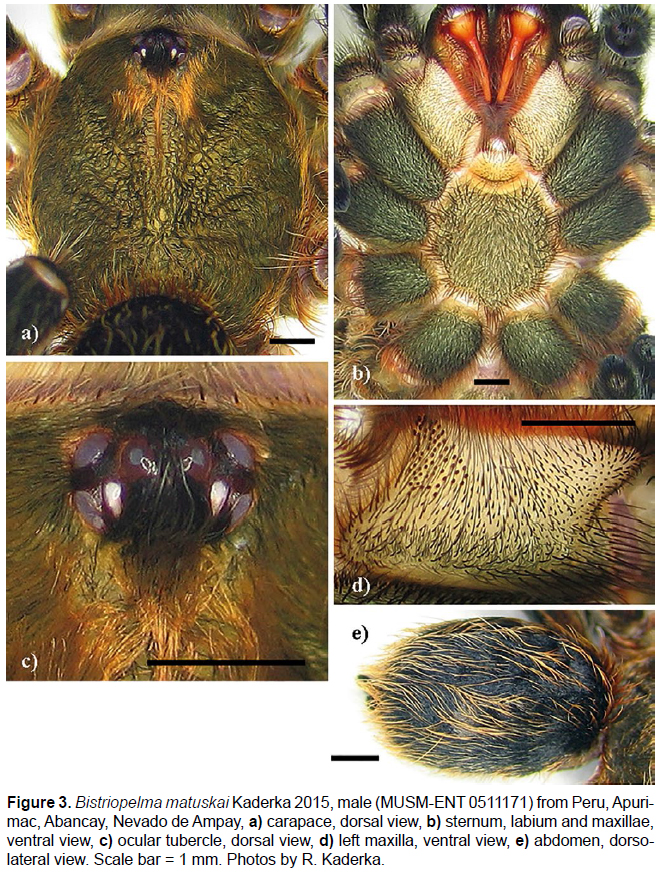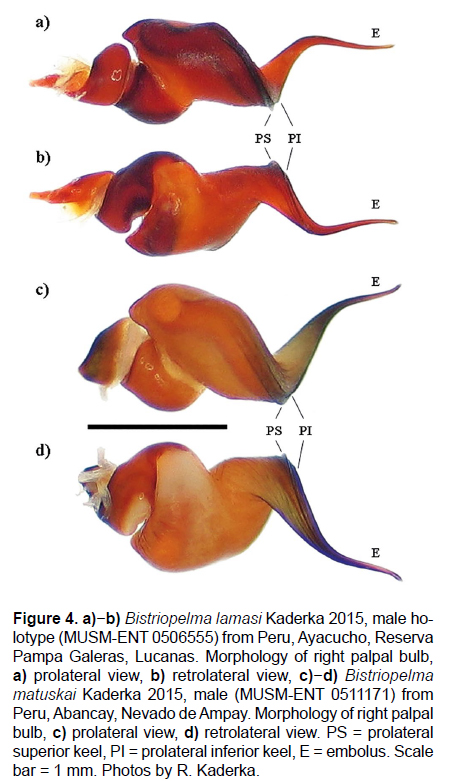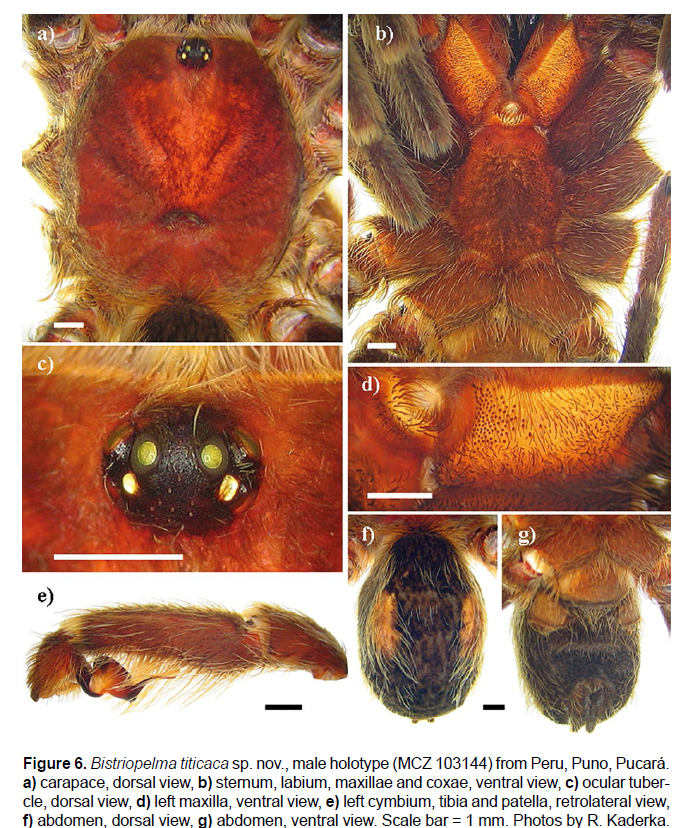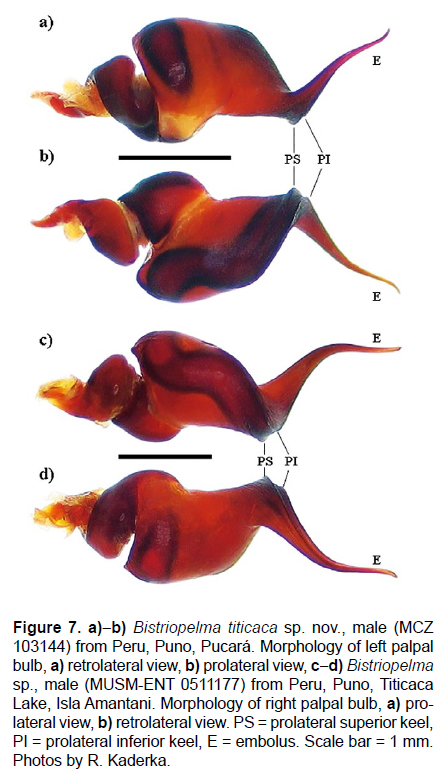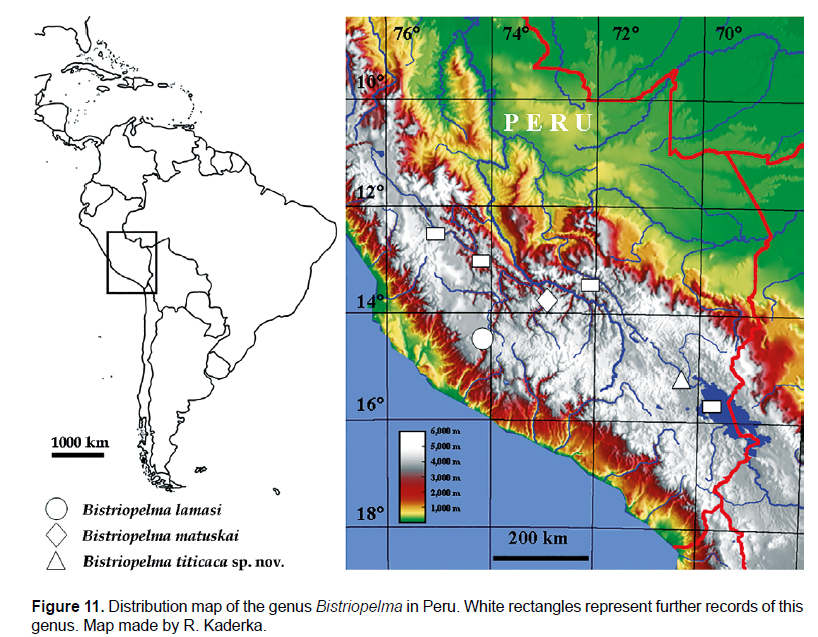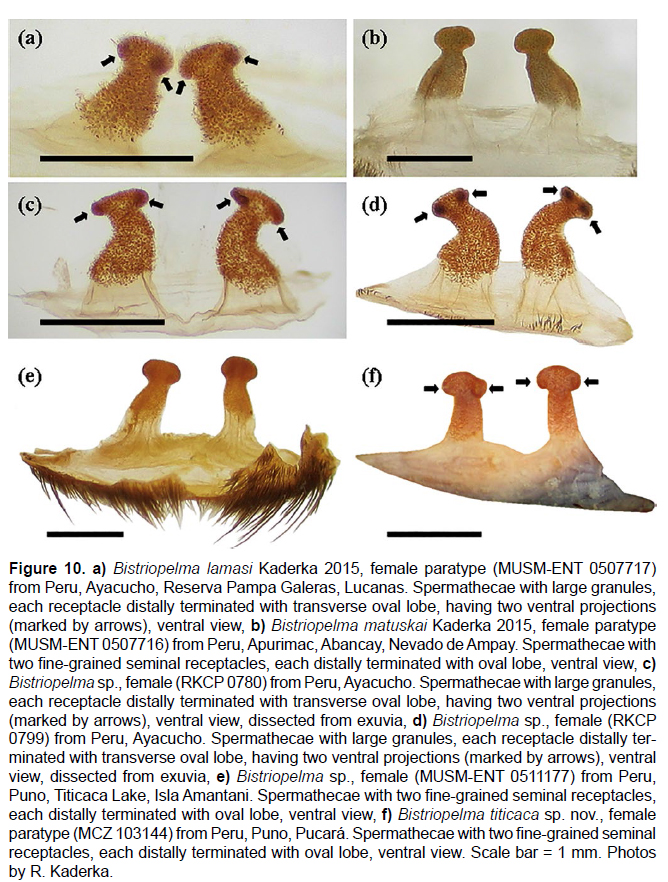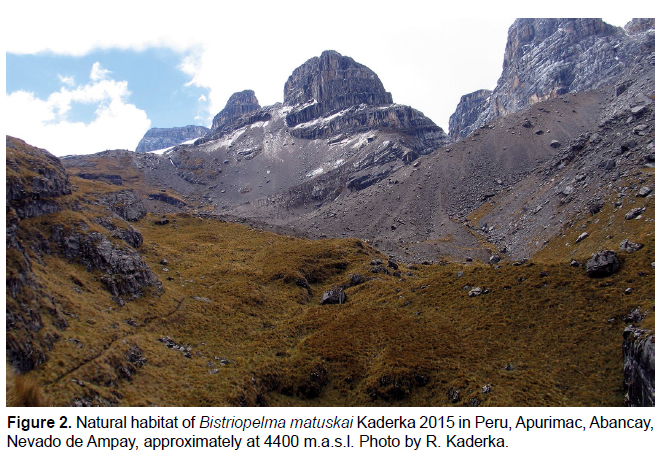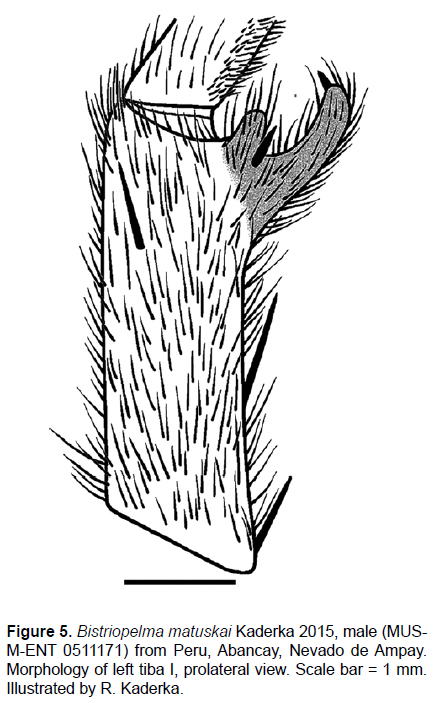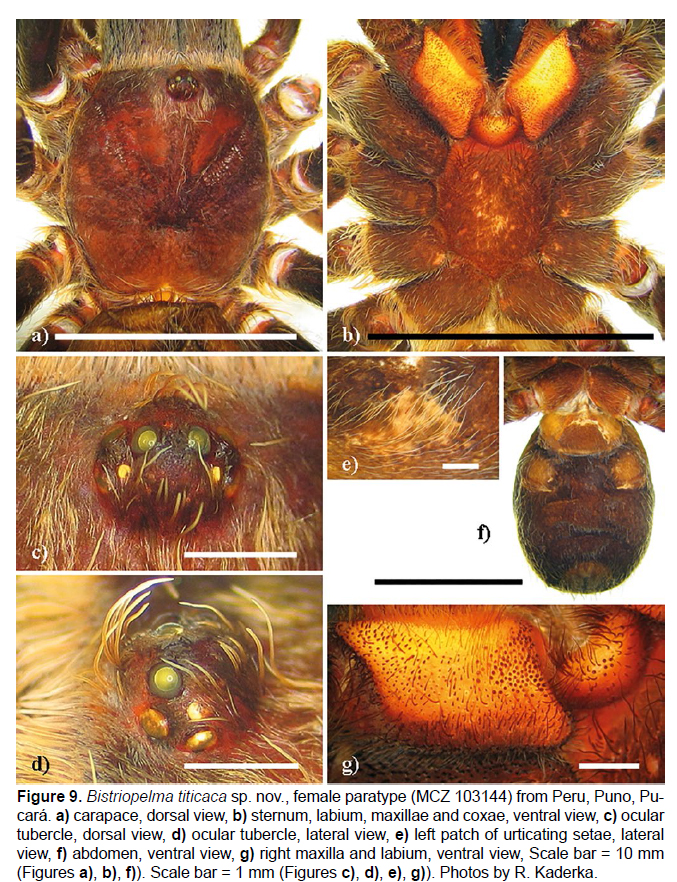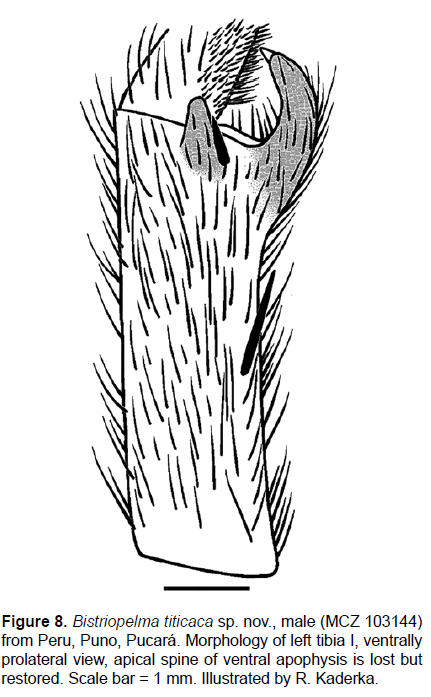Services on Demand
Journal
Article
Indicators
-
 Cited by SciELO
Cited by SciELO
Related links
-
 Similars in
SciELO
Similars in
SciELO  uBio
uBio
Share
Revista Peruana de Biología
On-line version ISSN 1727-9933
Rev. peru biol. vol.24 no.3 Lima Sept./Dec. 2017
http://dx.doi.org/10.15381/rpb.v24i3.13904
TRABAJOS ORIGINALES
Description of the male of Bistriopelma matuskai Kaderka 2015 and a new species of Bistriopelma from Peru (Araneae: Theraphosidae: Theraphosinae)
Descripción del macho de Bistriopelma matuskai Kaderka 2015 y de una nueva especie de Bistriopelma de Perú (Araneae: Theraphosidae: Theraphosinae)
Radan Kaderka
Address: Tyrsovo namesti 1732, 252 63 Roztoky u Prahy, Czech Republic
Email:radan.kaderka@seznam.cz
Abstract
The male of Bistriopelma matuskai Kaderka 2015 is described and illustrated, the species is rediagnosed and complemented by new biogeographical data. Additionally, a new species of Bistriopelma, B. titicaca sp. nov., from the Puno region in Peru is described, diagnosed and illustrated. An updated general description and distribution map of Bistriopelma are provided.
Keywords: Araneae; Mygalomorphae; Peru; South America; taxonomy.
Resumen
Se describe e ilustra el macho de Bistriopelma matuskai Kaderka 2015, se presenta una nueva diagnosis de la especie junto con nuevos datos biogeográficos. Adicionalmente, se describe, diagnostica e ilustra una nueva especie de Bistriopelma, B. titicaca sp. nov., del departamento de Puno en Perú. Se provee una descripción general actualizada y un mapa de distribución para el género.
Palabras clave: América del Sur; Araneae; Mygalomorphae; Perú; taxonomía.
Introduction
The New World theraphosids comprise of more than 60% of the world´s 959 described species (World Spider Catalog 2017) and many species are still unknown to science. Approximately 60% of the genera are described from Latin America and the phylogeny of this group, especially the subfamily Theraphosinae, is still a subject of research because of their high biogeographical diversity and morphological variability (Pérez-Miles et al. 1996; West et al. 2008; Bertani 2012; Guadanucci 2014; Perafán et al. 2016; Turner et al. 2017).
In 2015, Kaderka described a new theraphosine genus Bistriopelma from the Andean region in Peru, with two new species: Bistriopelma lamasi Kaderka 2015, based on the male holotype and the female paratype from Ayacucho, Reserva Pampa Galeras, and Bistriopelma matuskai Kaderka 2015, based on the female holotype from Abancay, Nevado de Ampay. Later, in October 2016, a single male of Bistriopelma matuskai was found during field work on the slopes of Nevado de Ampay, at an altitude of 4535 m.a.s.l. This male is described and illustrated, herein, and the species is rediagnosed.
In March 2017, from the examination of material deposited at the Museum of Comparative Zoology (MCZ), a new species of Bistriopelma was discovered and is, herein, described.
Material and methods
Abbreviations: Eye sizes and interdistances: AME = anterior median eyes, ALE = anterior lateral eyes, OQ = ocular quadrangle (including lateral eyes), PME = posterior median eyes, PLE = posterior lateral eyes. Spination: d = dorsal, p = prolateral, r= retrolateral, v = ventral. Male palpal bulb: E = embolus, PI = prolateral inferior keel, PS = prolateral superior keel. Cheliceral teeth pattern: v = small teeth, V = big teeth, = space. PLS = posterior lateral spinnerets, PMS = posterior median spinnerets. Collections: MCZ = Museum of Comparative Zoology, Cambridge, U.S.A. MUSM = Museo de Historia Natural, Lima, Peru. RKCP = Radan Kaderka private collection, Prague, Czech Republic. m.a.s.l. = metres above sea level.
All measurements were taken with an ocular micrometer of a binocular microscope Leica S6D according to the central axis of structures, except for the measurement of the total body length including cephalothorax and abdomen without spinnerets which was made using a calliper. All measurements are given in millimetres. The measurements of the leg and palpal segments were taken dorsally. The eye measurements were taken from the widest spans of the lens, AME in dorsal view, ALE, PLE and PME in dorsolateral view.
The extent of tarsal and metatarsal scopulae on ventral side of both leg segments was expressed as a percentage of the total length of segment, from apical end.
The leg spination was described using the following method: each leg segment was divided into four quadrants (ventral, prolateral, retrolateral and dorsal) and each quadrant described separately in basal, central and apical section, e.g. metatarsus I v 1-0-3 means that in the ventral plane (quadrant) there is one spine in basal section and three spines in apical section. If the bases of all three spine in apical section are located apically, then their position would be described by the term "apical" in brackets as in Bertani (2001). Unequal numbers of spines on the right and left side of the same leg segment were expressed by parentheses.
The denticulation of paired tarsal claws is described separately for prolateral and retrolateral claw (prolateral/retrolateral).
The terminology of male palpal bulb structures follows Bertani (2000). The terminology of subapical apophyses on tibia I follows Vol (2000).
The abdominal urticating setae were removed by forceps, placed in alcohol and examined by a microscope Leica S6D. The terminology of urticating setae follows Cooke et al. (1972). The barbs of urticating setae whose tips are oriented to the seta base are considered as reversed.
Images were made with a Canon G5, directly or via eyepiece of microscope Leica S6D.
During a field work the outside temperature was measured using a digital thermometer EMOS E0041. GPS co-ordinates were obtained using a Garmin Etrex 20. The distribution map of the genus Bistriopelma was created using the topographic map of Peru freely available on Wikimedia Commons.
Other material examined: Bistriopelma lamasi Kaderka 2015, male holotype (MUSM-ENT 0506555) from Peru, Ayacucho, Reserva Pampa Galeras, Lucanas, altitude 4.000 m a.s.l., April 21, 1974, G. Lamas M. col.; female paratype (MUSM-ENT 0507717) from Peru, Ayacucho, Reserva Nacional Pampa Galeras, Lucanas, 14°37.533'S 74°17.355'W, 3749 m a.s.l., 25.IX.2014, R. Kaderka col.; Bistriopelma matuskai Kaderka 2015, female holotype (MUSM-ENT 0507716) from Peru, Apurimac, Abancay, Nevado de Ampay, 13°34.182'S 72°53.791'W, 4003 m a.s.l., September 23, 2014, R. Kaderka col.; Bistriopelma matuskai Kaderka 2015, ale paratype (MUSMENT 0511171) from Peru, Apurimac, Abancay, Nevado de Ampay, 13°34.047’S, 72°54.847’W, 4535 m.a.s.l., October 24, 2016, R. Kaderka col.; Bistriopelma sp., female (RKCP 0780, exuvia) from Peru, Ayacucho, 3808 m.a.s.l., 2011, M. Černička col.; Bistriopelma sp., female (RKCP 0799, exuvia) from Peru, Ayacucho, 4083 m.a.s.l., October 28, 2016, R. Kaderka col.; Bistriopelma sp., male and female (MUSM-ENT 0511177) from Peru, Puno, Titicaca Lake, Isla Amantani, altitude 3900 m.a.s.l., March 1948, Fortunato Blancas col.
Taxonomy
Order: Araneae Clerck 1757
Infraorder: Mygalomorphae Pocock 1892
Family: Theraphosidae Thorell 1869
Subfamily: Theraphosinae Thorell 1869
Genus Bistriopelma Kaderka 2015
Type species: Bistriopelma lamasi Kaderka 2015
Diagnosis (from Kaderka 2015): Bistriopelma differs from all other theraphosid genera, except the genus Phrixotrichus Simon 1889 (sensu Perafán & Pérez-Miles 2014a) and the troglobite species Tmesiphantes hypogeus Bertani, Bichuette & Pedroso 2013 by having two abdominal dorsolateral patches of the type III urticating setae, each with a stripe of long pale to reddish-brown thicker setae, arranged diagonally to the longitudinal body axis. Bistriopelma can be distiguished from Phrixotrichus by the shape of spermathecae in females, consisting of two separate subparallel seminal receptacles in Bistriopelma but strongly divergent in Phrixotrichus; by the different morphology of the male palpal bulb having the embolus projecting retrolaterally from tegulum (contra posteriorly in Phrixotrichus, Kaderka 2015: figures 32–33); furthermore, by the presence of basal spine on prolateral tibial apophysis (absent in Phrixotrichus); the absence of the type IV urticating setae and by paired tarsal claws denticulate (smooth in Phrixotrichus). It can be distinguished from Tmesiphantes hypogeus by the position of urticating setal patch in the middle of abdomen (in posterior half in Tmesiphantes hypogeus), the well-developed scopulae on metatarsi I and II covering 80–100% of this leg segment (30% in tarsi I and II in T. hypogeus), the presence of scopulae on metatarsi IV covering 25–30% of this leg segment in Bistriopelma (absent in T. hypogeus) and the shape of spermathecae with long seminal receptacles with subapical constriction in Bistriopelma and short, subtriangular and widely separated in T. hypogeus.
General description (modified from Kaderka 2015):
The genus Bistriopelma comprises small to medium-sized theraphosid spiders, with total length 12.5 up to 24.8 mm, excluding chelicerae and spinnerets. Carapace oval, uniformly coloured. Caput domed. Ocular tubercle oval (Figures 9c, 9d, Kaderka 2015: figures 4, 16, 25), strongly elevated, distinctly wider than longer, with eight eyes, anterior eye row slightly procurved, posterior row recurved in dorsal view. Clypeus indistinct to narrow. Fovea transverse, straight or slightly recurved, deep or absent in Bistriopelma matuskai and Bistriopelma sp. from Peru, Ayacucho. Chelicerae without rastellum and stridulatory bristles, with teeth on promargin (7–10), first basal teeth are complemented with granulation. Labium domed, wider than long, with reduced number of cuspules in anterior third (1–11), maxillae with 67–142 cuspules in basal third on ventral side. Almost all maxillary cuspules are located on indistinctly or distinctly elevated area. Apical half of ventral maxillae covered with short spiniform setae (Figure 3d, 6d, Kaderka 2015: figures 20, 29). Maxillary lobe pronounced into conical process. Labiosternal groove distinct, shallow and flat, with two joined elongated sigilla. Sternum oval, with three pairs of small, oval sigilla located near coxae III, coxae II and coxae I, posterior sigilla separated from the margin approximately by their own 2.4–7.0 diameters. Legs uniformly hirsute. Leg pattern (from longest to shortest): I>IV>II>III (male holotype of Bistriopelma lamasi, Bistriopelma matuskai, Bistriopelma titicaca sp. nov.) or IV>I>II>III (female paratype of Bistriopelma lamasi). Leg segments: generally uniform, except for incrassate femur III in adult males.
Dense scopulae on ventral side of all tarsi, metatarsi I–II 80–100% scopulate, posterior metatarsi partly scopulate, scopulae more extended on anterior than on posterior legs. Tarsal scopulae I, II usually undivided, in tarsi III, IV usually divided by a longitudinal band of setae. Retrolateral side of femur IV and prolateral side of femur I without pad of plumose setae. Maxillary and trochanteral stridulatory setae or bristles absent. Dorsal face of all tarsi and cymbium with two irregular longitudinal rows of very short claviform trichobothria. Paired tarsal claws with teeth (0–8), third claw absent in all tarsi. Claw tufts dense, bilobate, present on all tarsi.
Abdomen uniformly coloured, with two pale dorsolateral stripes of urticating setae (Figures 6f, 6g, Kaderka 2015: figures 7, 19, 28). Urticating setae of the type III. Four spinnerets present.
PLS composed of three digitiform segments. PMS digitiform, one-segmentated.
Cymbium dorsally with or without spiniform setae, cymbial lobes almost equal or prolateral cymbial lobe distinctly larger than retrolateral lobe. Palpal tibia without retrolateral process. Two unequal tibial apophyses are present on tibia I (Figures 5, 8, Kaderka 2015: Figure 11): a longer ventral tibial apophysis, at least with short apical spine, and a shorter prolateral tibial apophysis with single, retrolateral spine at base. Metatarsus I not sigmoidly curved, without basal or median protuberance on retrolateral face; it contacts the ventral tibial apophysis when flexed. Male palpal organ with a narrow embolus projecting retrolaterally from tegulum, sigmoidly curved (Figures 4, 7), with two subparallel prolateral keels, PS and PI keel. Tegulum with short conical basal apophysis, projecting anteriorly to prolaterally.
Females with spermathecae composed of two separated seminal receptacles, each with subapical constriction, oval or rounded apical lobe and without sclerotized basal plates (Figure 10). Both apical lobes in Bistriopelma lamasi, Bistriopelma titicaca sp. nov. and Bistriopelma sp. from Peru, Ayacucho with two ventral projections (Figures 10a, 10c, 10d, 10f ). Both seminal receptacles can be sclerotized with large granules (Figures 10a, 10c, 10d) or fine-grained (Figures 10b, 10e, 10f ).
Species included: Bistriopelma lamasi Kaderka 2015, Bistriopelma matuskai Kaderka 2015, Bistriopelma titicaca sp. nov.
Bistriopelma matuskai Kaderka 2015
Figures 1–3, 4c, 4d, 10b, 11, Tables 1, 2
Bistriopelma matuskai: Kaderka 2015: 282–285, figures 13, 21–29, 31.
Type: Female holotype (MUSM-ENT 0507716) from Peru, Apurimac, Abancay, Nevado de Ampay, 13°34.182'S 72°53.791'W, 4003 m a.s.l., September 23, 2014, R. Kaderka col.
Diagnosis (modified from Kaderka 2015): Bistriopelma matuskai differs from B. lamasi and B. titicaca sp. nov. in the absence of fovea. Females differ from B. lamasi in fine-grained seminal receptacles (large granules in B. lamasi) and the different leg pattern (I>IV>II>III in B. matuskai and IV>I>II>III in B. lamasi). Females also differ from B. lamasi and B. titicaca sp. nov. in the undeveloped basal tubercle covered with maxillary cuspules (developed in B. lamasi and B. titicaca sp. nov.), and different setation of ventral maxilla without posterior band of dark pubescens (present in B. lamasi and B. titicaca sp. nov.) (Kaderka 2015: figures 20, 29). Males differ from B. lamasi and B. titicaca sp. nov. in having almost equal cymbial lobes (prolateral cymbial lobe is distinctly larger in B. lamasi and B. titicaca sp. nov.), and in cymbium without spiniform setae (with spiniform setae in B. lamasi and B. titicaca sp. nov.).
Distribution (Figures 2, 11): Known only from the type locality.
MALE (MUSM-ENT 0511171): Total length: 12.52, carapace (Figure 3a), length 6.67, width 6.11, chelicerae with 9–10 teeth on promargin. Cheliceral teeth pattern from the basal end: right side: V-V-vvvvvVV. Left side: V-V-vvvvvVVv. Anterior eye row slightly procurved, posterior eye row recurved. Eye sizes and interdistances: AME 0.286 (circular), ALE 0.312 (oval), PME 0.247 (drop-like), PLE 0.325 (oval), AME-AME 0.169, AME-ALE 0.117, PME-PME 0.572, PME-PLE 0.073, ALE- PLE 0.143, AME-PME 0.062, OQ length 0.650, width 1.170. Ocular tubercle strongly elevated (Figure 3c), length 0.884, width 1.170, clypeus absent. Fovea absent. Labium length 0.86, width 1.40, anterior half with 3 cuspules, maxillae with 67–77 cuspules, located in basal, indistinctly elevated tubercles, except few of them (Figure 3d). Apical half of maxilla with spiniform setae (Figure 3d). Maxillary and trochanteral stridulatory bristles absent. Sternum (Figure 3b), length 3.10, width 3.51, with three pairs of oval sternal sigilla located near coxae III (0.182, 0.624 from the edge of sternum), coxae II (0.143, 0.468 from the edge of sternum) and near coxae I (0.130, 0.312 from the edge of sternum). Leg pattern: I>IV>II>III. Incrassate leg segments: slightly incrassate femur III.
Scopulae: All tarsi, 100% scopulate, metatarsi I-II 90%, metatarsi III 50% and metatarsi IV 25% scopulate. Tarsi I with scopula entire, scopula of tarsi II divided by a line of setae, in tarsi III-IV divided by a band of setae. Dorsal face of all tarsi and cymbium with two irregular longitudinal rows of very short claviform trichobothria. Denticulation pattern of paired tarsal claws on left leg (prolateral/retrolateral row): I 5/5, II 3/3, III 3/2, IV 3/3. Pad of plumose setae on retrolateral face of femur IV absent.
Spination: femora I p 0-0-1, II 0, III 0, IV 0 and femora of palps 0; patellae I–IV 0 and patellae of palps 0; tibiae I p 0-1-0, r 2-2-2, II v 2-1-4, p 0-1-0, III v 1-2-1 (apical), r 0-1-0, IV r 0-1-0 and tibiae of palps p 0-1-0; metatarsi I v 0-0-1 (apical), II v 0-(0–1)-3 (apical), III v 0-1-3 (apical), p 0-1-1, r 0-1-1-1, IV v 0-1-3 (apical), p 0-1-1, r 0-1-1, tarsi I–IV and tarsi of palps 0.
Cymbium dorsally without spiniform setae, cymbial lobes almost equal, not covered with spiniform setae. Palpal tibia is tapering to the apex. Two unequal tibial apophyses present on tibia I (Figure 5): a ventral tibial apophysis with a single apical spine, a prolateral tibial apophysis with a single inner spine, approximately of the same length as the apophysis. Metatarsus I contacts the apex of ventral tibial apophysis when flexed. Palpal bulb (Figures 4c, 4d) with a narrow embolus projecting retrolaterally from tegulum, sigmoidly curved, and two subparallel keels, PS and PI keel, both keels smooth. Tegulum with short conical basal apophysis.
Abdomen (Figure 3e) with type III urticating setae located in two dorsolateral patches, 2.62 distant from each other. Urticating setal patch: length 2.34, width 1.52. Abdomen length 7.02, width 4.89. PLS three-segmented, length 2.40, basal segment 1.07, middle segment 0.52, apical segment 0.81, all digitiform. PMS one-segmented, length 0.52.
Coloration: dorsal view (Figure 1): black, carapace and femora covered with short golden setae, legs black with long pale setae, apical end of femora, patellae, tibiae and metatarsi with rings of short pale setae, abdomen covered with long pale setae, except for two abdominal dorsolateral patches of urticating setae covered with long reddish-brown thicker setae, arranged diagonally to the longitudinal body axis. Spinnerets black. Patellae I, II and palpal patella with two almost equal longitudinal stripes, patellae III, IV with two unequal diagonal stripes. Ventral view: labium and maxillae light brown, sternum, coxae, trochantera dark grey, fangs reddish-brown, abdomen black, except for area above epigastric scutum which is grey.
Biological and ecological notes: Bistriopelma matuskai is a fossorial, cold-adapted species inhabiting altitudes of approximately 3900–4500 m.a.s.l. The typical habitat of this species comprises mountain grass slopes covered with stones under which spiders have their burrows. The temperatures at the altitude of 3860 m.a.s.l. during the first collecting day: 14.2°C (2:30 p.m.), 8.0°C (5:30 p.m.), 5.5°C (6:30 p.m.), 4.7°C (7:00 p.m.). The temperatures during the second collecting day: 4.8°C (7:00 a.m., 3860 m.a.s.l.), 11.7°C (11:00 a.m., 4000 m.a.s.l., sunny), 15.8°C (11:30 a.m., 4100 a.s.l.), 1.6°C (1:00 p.m., 4350 m.a.s.l., after the first hailstorm), 7.0°C (1:30 p.m., 4404 m.a.s.l.), 13.7°C (2:00 p.m., 4432 m.a.s.l., sunny), 4.2°C (3:30 p.m., 4720 m.a.s.l.). The temperature in the distribution area of B. matuskai may fall to near zero for a short time.
Bistriopelma titicaca sp. nov.
Figures 6, 7a, 7b, 8, 9, 10f, 11, Tables 3, 4, 5
Types: Male holotype (MCZ 103144) and female paratype (MCZ 143649) from Peru, Puno, Pucará, 3904–3965 m.a.s.l., February – June, 1939, A. Kidder II col.
Diagnosis: Females of Bistriopelma titicaca sp. nov. differ from B. lamasi in the fine-grained seminal receptacles (large granules in B. lamasi) and the different leg pattern (I>IV>II>III in B. titicaca sp. nov. and IV>I>II>III in B. lamasi). Males differ from B. lamasi in undeveloped basal tubercle covered with maxillary cuspules (developed in B. lamasi). Bistriopelma titicaca sp. nov. differs from B. matuskai in the presence of deep fovea (absent in B. matuskai), females differ from B. matuskai in the shape of fine-grained seminal receptacles having two ventral projections on oval terminal lobe (absent in B. matuskai) and in the different shape of a neck which is distinctly narrower in comparison to the width of oval terminal lobe (of the same width in B. matuskai). Females also differ in the developed basal tubercle covered with maxillary cuspules (undeveloped in B. matuskai) and different setation of ventral maxilla with posterior band of dark pubescens (absent in B. matuskai) (Figure 9g, Kaderka 2015: figure 29). Males differ from B. matuskai in having distinctly larger prolateral cymbial lobe than retrolateral one (almost equal lobes in B. matuskai), and in cymbium with spiniform setae (absent in B. matuskai).
Etymology: The specific name refers to the type locality near Titicaca Lake on the Peruvian-Bolivian frontier.
Distribution (Figure 11): Known only from the type locality.
MALE (MCZ 103144): Total length: 17.82, carapace (Figure 6a), length 9.16, width 8.25, chelicerae with 10 teeth on promargin. Cheliceral teeth pattern from the basal end: right side: V-V-V-VVVVV-VV. Left side: V-V-V-VVVVVVv. Anterior eye row procurved, posterior eye row recurved. Eye sizes and interdistances: AME 0.338 (circular), ALE 0.312 (oval), PME 0.234 (oval), AME-AME 0.286, AME-ALE 0.065, PME-PME 0.611, PME-PLE 0.055, ALE-PLE 0.182, AME-PME 0.039, OQ length 0.702, width 1.248. Ocular tubercle strongly elevated (Figure 6c), length 1.066, width 1.248, clypeus absent. Fovea transverse, deep, slightly recurved, width 1.69, 6.11 from the anterior edge of carapace. Labium posteriorly depressed, length 0.89, width 1.75, anterior half with 1 cuspule, maxillae with 102–109 cuspules in basal third, most of them located in flattened basal tubercle (Figure 6d). Apical half of maxilla with short spiniform setae (Figure 6d). Maxillary and trochanteral stridulatory bristles absent. Sternum (Figure 6b), length 4.83, width 4.06, with three pairs of oval sternal sigilla located near coxae III (0.247, 0.586 from the edge of sternum), coxae II (0.216, 0.345 from the edge of sternum) and near coxae I (0.213, 0.320 from the edge of sternum). Cuspules on labiosternal suture joined. Leg pattern: I>IV>II>III. Incrassate leg segments: incrassate femur III.
Scopulae: All tarsi, 100% scopulate, metatarsi I-II 100%, metatarsi III 60% and metatarsi IV 30% scopulate. Tarsi I-II with scopula entire, scopulae of tarsi III-IV divided by a band of setae. Dorsal face of all tarsi and cymbium with two irregular longitudinal rows of very short claviform trichobothria. Denticulation pattern of paired tarsal claws on right leg (prolateral/ retrolateral row): I 8/5, II 6/6, III 5/5, IV 3/7. Pad of plumose setae on retrolateral face of femur IV absent. Prolateral faces of coxae I and II densely covered with short spiniform setae.
Spination: femora I p 0-0-1, II p 0-0-1, III p 0-0-1, IV 0 and femora of palps p 0-0-1; patellae I−IV 0 and patellae of palps 0; tibiae I v 1-1-0, p 0-1-1, r 0-0-2 (apical, in the base of retrolateral tibial apophysis), II v 1-1-0, p 0-1-1, III v 1-1-1, p 0-2-(0−1), r 1-0-1, IV v 0-1-(0−1), p 0-1-0, r 0-0-1 and tibiae of palps p 0-1-1; metatarsi I v 0-0-1 (apical), p 1-0-0, II v 1-0-3 (apical), III v 0-0-2 (apical), p 0-(1−2)-2, r 1-1-1-1, IV v 0-1-0, p 0-0-1, r 1-1-(1−2), tarsi I−IV and tarsi of palps 0.
Cymbium with two unequal cymbial lobes, prolateral lobe distinctly larger than retrolateral one. The area between lobes dorsally covered with short spiniform setae. Palpal tibia is tapering to the apex (Figure 6e), a retrolateral process is absent. Two unequal tibial apophyses present on tibia I (Figure 8): a long ventral tibial apophysis with a single apical spine and a short prolateral tibial apophysis with a single inner spine, approximately of the same length as the apophysis. Slightly bent metatarsus I contacts the apex of ventral tibial apophysis when flexed. Palpal bulb (Figures 7a, 7b) with a narrow embolus projecting retrolaterally from tegulum, sigmoidly curved, and two smooth subparallel keels, PS and PI keel. Tegulum with short conical basal apophysis projecting prolaterally.
Abdomen (Figures 6f, 6g) with type III urticating setae located in two dorsolateral patches, 3.05 distant from each other. Urticating setal patch: length 2.90, width 1.22. Abdomen length 8.76, width 6.11. PLS three-segmented, length 2.96, basal segment 1.01, middle segment 0.78, apical segment 1.17, all digitiform. PMS one-segmented, length 0.68.
Coloration (damaged by the long-term preservation in alcohol): dorsal view: carapace reddish brown covered with short dark setae, edge of carapace with long pale setae, ocular tubercle black, abdomen black, laterally covered with long pale setae, and with two light brown dorsolateral patches of urticating setae covered with long pale setae, arranged diagonally to the longitudinal body axis. Spinnerets black. Patellae I, II and palpal patella with two almost equal longitudinal stripes without covering pubescens, patellae III, IV with two unequal diagonal stripes. Ventral view: labium and maxillae yellowish brown, sternum and coxae brown, abdomen black, except for area above epigastric scutum and both posterior booklungs which are light brown.
FEMALE (MCZ 103144): Total length: 22.63, carapace (Figure 9a), length 9.57, width 8.65, chelicerae with 8–9 teeth on promargin. Cheliceral teeth pattern from the basal end: right side: V-V-VVVVV-V. Left side: V-V-VVVVVVVV. Anterior eye row procurved, posterior eye row recurved. Eye sizes and interdistances: AME 0.289 (circular), ALE 0.270 (oval), PME 0.156 (oval), PLE 0.291 (oval), AME-AME 0.234, AME-ALE 0.104, PME-PME 0.689, PME-PLE 0.091, ALE-PLE 0.138, AME- PME 0.130, OQ length 0.663, width 1.339. Ocular tubercle strongly elevated (Figures 9c, 9d), length 1.248, width 1.339, clypeus narrow, 0.156 long. Fovea transverse, deep, width 1.25, 6.74 from the anterior edge of carapace. Labium length 1.18, width 2.01, with 11 cuspules in apical half, each maxilla with 113 cuspules, located anteriorly in basal half in distinct basal tubercle (Figure 9g). Apical half of maxilla is ventrally covered with short spiniform setae. Maxillary and trochanteral stridulatory bristles absent. Sternum (Figure 9b), length 5.61, width 4.27, with three pairs of small and narrow sternal sigilla located near coxae III (oval 0.234, 0.754 from the edge of sternum), coxae II (oval 0.177, 0.442 from the edge of sternum) and near coxae I (oval 0.143, 0.395 from the edge of sternum). All sigilla distant approximately 3 diameters from the edge of carapace. Leg pattern: I>IV>II>III. Incrassate leg segments absent. Maxillary and trochanteral stridulatory bristles absent.
Scopulae: All tarsi 100% scopulate, metatarsi I 100%, metatarsi II 80%, metatarsi III 70% and metatarsi IV 50% scopulate. Tarsi I-II with scopula entire, scopula of tarsi III divided by a line of longitudinal setae, in tarsi IV divided by a wide band of setae. Dorsal face of all tarsi with two irregular longitudinal rows of very short claviform trichobothria. All paired tarsal claws with 2–4 teeth on each segment: I: 3/4, II: 4/2, III: 3/3, IV: 3/4. Plumose setae on retrolateral face of femur IV absent. Prolateral faces of coxae I–IV densely covered with short spiniform setae.
Spination: femora I p 0-0-1, femora II–IV and femora of palps p 0-0-1; patellae I−IV and patellae of palps 0; tibiae I 0, II p 0-1-0, III v (0–1) (apical), p 0-1-0, r 0-1-0, IV r 0-1-0 and tibiae of palps 0; metatarsi I v 0-0-1 (apical), II v 1-0-1 (apical), p 0-1-0, III v 1-2-1-2 (apical), p 0-1-1, d 0-1-1, IV v 0-1-0, p 0-0-1, r 0-0-1 (apical), d 0-1-1, tarsi I–IV and tarsi of palps 0.
Spermathecae (Figure 10f ): two separated seminal receptacles, fine grained, each distally ended with oval lobe, having two ventral projections.
Abdomen (Figure 9f) with type III urticating setae located in two dorsolateral patches, 5.32 distant from each other. Urticating setal patch (Figure 9e): length 3.10, width 1.68. PLS three-segmented, length 3.16, basal segment 1.46, middle segment 0.76, apical segment 0.94, all digitiform. PMS one-segmented, length 1.07.
Coloration: dorsal view: carapace dark brown, without long setae, except for a row of setae between anterior edge of ocular tubercle and fovea and setae on the edge of carapace. Legs dark brown intermixed with long pale setae, abdomen dark brown, except for two lighter dorsolateral patches of urticating setae covered with long reddish-brown setae, arranged diagonally to the longitudinal body axis. Patellae I, II with two almost equal longitudinal stripes without covering pubescens, patellae III, IV with one diagonal stripes without covering pubescens. Ventral view: dark brown, except for reddish brown maxillae and labium. Sternum covered with long brown setae, missing in central part. Spinnerets brown.
Acknowledgement
I would like to express my gratitude to Diana Silva Dávila from Museo de Historia Natural, Lima, Peru for her assistance during my visit to the MUSM spider collection and for comments on an earlier version of this manuscript, to Gonzalo Giribet and Laura Leibensperger from Museum of Comparative Zoology, Cambridge, U.S.A. for providing the type and nontype material of Homoeomma peruvianum from Yale Peruvian Expedition in 1911, and also two additional specimens which were, herein, described as a new species of Bistriopelma, further to Rick C. West from Canada and one anonymous reviewer for valuable comments on the manuscript and to Carlos Perafán from Uruguay for correction of Spanish abstract. The field work in Peru was carried out under collection permit No. 154-2016-SERFOR/DGGSPFFS.
Literature cited
Bertani R. 2000. Male palpal bulbs and homologous features in Theraphosinae (Araneae: Theraphosidae). Journal of Arachnology, 28: 29−42.
Bertani R. 2001. Revision, cladistic analysis, and zoogeography of Vitalius, Nhandu, and Proshapalopus; with notes on other theraphosine genera (Araneae, Theraphosidae). Arquivos de Zoologia, São Paulo, 36 (3): 265−356.
Bertani R. 2012. Revision, cladistic analysis and biogeography of Typhlochlaena C. L. Koch, 1850, Pachistopelma Pocock, 1901 and Iridopelma Pocock, 1901 (Areaneae, Theraphosidae, Aviculariinae) from Brazil. ZooKeys, 230: 1–94. DOI: https://doi.org/10.3897/zookeys.230.3500 [ Links ]
Bertani R., M.E. Bichuette & D.R. Pedroso. 2013. Tmesiphantes hypogeus sp. nov. (Araneae: Theraphosidae), the first troglobitic tarantula from Brazil. Anais da Academia Brasileira de Ciências, 85: 235−243. DOI: http://dx.doi.org/10.1590/ S0001-37652013005000007
Clerc C. 1757. Aranei Svecici, descriptionibus et figuris aeneis illustrati, ad genera subalterna redacti, speciebus ultra LX determinati. Regiae Societatis Scientiarum Upsaliensis, Stockholmiae. 154pp. [ Links ]
Cooke J.A.L., V.D. Roth & F.H. Miller. 1972. The urticating hairs of theraphosid spiders. American Museum Novitates, 2498: 1−43.
Guadanucci J.P.L. 2014. Theraphosidae phylogeny: relationship of the ´Ischnocolinae´ genera (Araneae, Mygalomorphae). Zoologica Skripta, 43: 518–518. DOI http://dx.doi. org/10.1111/zsc.12065 [ Links ]
Kaderka R. 2015. Bistriopelma, a new genus with two new species from Peru (Araneae: Theraphosidae: Theraphosinae). Revista Peruana de Biología, 22 (3): 275–288. DOI: http://dx.doi. org/10.15381/rpb.v22i3.11432 [ Links ]
Perafán C. & F. Pérez-Miles. 2014. The Andean tarantulas Euathlus Ausserer, 1875, Paraphysa Simon, 1892 and Phrixotrichus Simon, 1889 (Araneae, Theraphosidae): phylogenetic analysis, genera redefinition and new species descriptions. Journal of Natural History: 1−30. DOI: http://dx.doi.org/ 10.1080/00222933.2014.902142
Perafán C., Galvis W., Gutiérrez M. & F. Pérez-Miles. 2016. Kankuamo, a new genus from Colombia (Araneae, Mygalomorphae), with a new type of urticating setae and divergent male genitalia. ZooKeys, 601: 89–109. DOI: http://dx.doi. org/10.3897/zookeys.601.7704 [ Links ]
Pérez-Miles F.; S.M. Lucas, P.I. Da Silva & R. Bertani. 1996. Systematic revision and cladistic analysis of Theraphosinae (Araneae: Theraphosidae). Mygalomorph 1:33-68. [ Links ]
Pocock R.I. 1892. Liphistius and its bearing upon the classification of spiders. Annals and Magazine of Natural History, 10 (6): 303−314.
Thorell T. 1869. On European spiders. Part I. Review of the European genera of spiders, preceded by some observations on zoological nomenclature. Nova Acta Regiae Societatis Scientiarum Upsaliensis, (3) 7: 1–108. [ Links ]
Turner, S.P., S.J. Longhorn, C.A. Hamilton, R. Gabriel, F. Pérez-Miles & A.P. Vogler. 2017. Re-evaluating conservation priorities of New World tarantula (Araneae: Theraphosidae) in a molecular framework indicates non-monophyly of the genera, Aphonopelma and Brachypelma. Systematics and Biodiversity, DOI: http://dx.doi.org/10.1080/14772000. 2017.1346719. [ Links ]
Vol F. 2000. Description de Bonnetina cyaneifemur, gen. n. & sp. n. (Araneae, Theraphosidae, Theraphosinae) du Mexique. Arachnides, 44: 2−9.
West R., Marshall S. D., Fukushima C. S. & R. Bertani. 2008. Review and cladistic analysis of the Neotropical tarantula genus Ephebopus Simon 1892 (Araneae: Theraphosidae). Zootaxa, 1849: 35–58. [ Links ]
World spider catalog. 2017. World Spider Catalog, version 18.0. Natural History Museum, Bern. Online at http://wsc.nmbe.ch. Accessed on April 22, 2017. [ Links ]
Presentado: 25/05/2017
Aceptado: 05/09/2017
Publicado online: 28/10/2017













